
A reef aquarium or reef tank is a marine aquarium that prominently displays live corals and other marine invertebrates as well as fish that play a role in maintaining the tropical coral reef environment. A reef aquarium requires appropriately intense lighting, turbulent water movement, and more stable water chemistry than fish-only marine aquaria, and careful consideration is given to which reef animals are appropriate and compatible with each other.
Fragmentation in multicellular or colonial organisms is a form of asexual reproduction or cloning, where an organism is split into fragments. Each of these fragments develop into mature, fully grown individuals that are clones of the original organism.
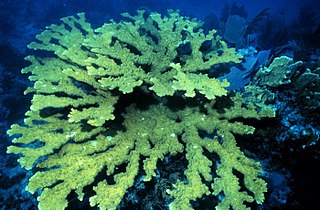
Elkhorn coral is an important reef-building coral in the Caribbean. The species has a complex structure with many branches which resemble that of elk antlers; hence, the common name. The branching structure creates habitat and shelter for many other reef species. Elkhorn coral is known to grow quickly with an average growth rate of 5 to 10 cm per year. They can reproduce both sexually and asexually, though asexual reproduction is much more common and occurs through a process called fragmentation.
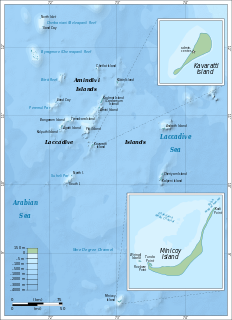
Kadmat Island, also known as Cardamom Island, is a coral island belonging to the Amindivi subgroup of islands of the Lakshadweep archipelago in India. Measuring 9.3 kilometres (5.8 mi) in length, the island has a lagoon with a width of 1.5 kilometres (0.93 mi) covering an area of 25 square kilometres (9.7 sq mi). The ecological feature of the island is of coral reef with seagrass, and marine turtles which nestle here. The Ministry of Environment and Forests (India) has notified the island as a marine protected area for ensuring conservation of the island's animal, plant, or other type of organism, and other resources.

Euphyllia divisa, commonly known as frogspawn coral and sometimes misspelled Euphyllia divisia, is a large-polyped stony coral native to the Indo-Pacific islands. It is a commonly kept species in the marine aquarium hobby. The related coral Euphyllia paradivisa is frequently misidentified as frogspawn leading to some confusion. Euphyllia divisa has a corallite skeleton with a flabello-meandroid "wall" structure whereas Euphyllia paradivisa has a tree-like branching structure with separate coralites.
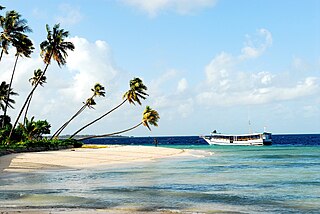
Wakatobi National Park is a marine national park in Southeast Sulawesi, Indonesia. The name of Wakatobi is a portmanteau of the four main Tukangbesi Islands: Wangi-wangi, Kaledupa, Tomia, and Binongko. Since 2005 the park is listed as a tentative World Heritage Site.
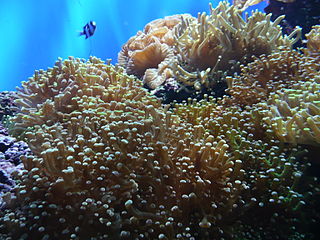
Euphyllia is a genus of large-polyped stony coral. Several species are commonly found in marine aquariums. The genus includes the following species:

Euphyllia ancora is a species of hard coral in the family Euphylliidae. It is known by several common names, including anchor coral and hammer coral, or less frequently as sausage coral, ridge coral, or bubble honeycomb coral.

Euphyllia cristata is commonly called grape coral. E. cristata is a kind of stony or hard coral in the family Euphylliidae; it also belongs to the genus Euphyllia in the order of Scleractinia. E. cristata has a wide range of distribution throughout the tropical waters of the Indo-West Pacific area with a large presence in Indonesia. However, despite this large range of distribution, E. cristata has a slightly lower abundance compared to other species, making them a little more uncommon to find. They are typically found in shallow waters from 1–35 meters deep.
Ridge coral may refer to several different taxa:

Euphyllia paradivisa, or branching frogspawn coral, is a species of large-polyped stony coral belonging to the Euphylliidae family. It shares the common name of "frogspawn coral" with Euphyllia divisa, but is differentiated as the "branching" frogspawn whereas Euphyllia divisa has a "wall" structure. It is a commonly kept species in the marine aquarium hobby.
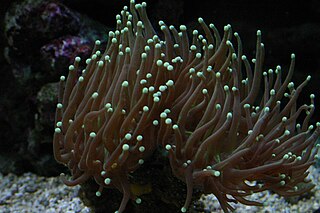
Euphyllia glabrescens is a species of large-polyped stony coral belonging to the family Caryophylliidae. Its common name is the torch coral due to its long sweeper tentacles tipped with potent cnidocytes. It is a commonly kept species in the marine aquarium hobby, particularly specimens from Indonesia and Fiji, who fulfilled annual export quotas of 28,000 and 6,000 pieces, respectively, in 2005.
Euphyllia baliensis, commonly known as bubble coral, is a species of large-polyped stony coral belonging to the family Euphylliidae.

Euphylliidae is a family of marine stony corals of the order Scleractinia.

Diogenes heteropsammicola is a species of hermit crab discovered during samplings between 2012 and 2016 in the shallow waters of the Japanese Amami Islands. This D. heteropsammicola is strongly associated with the walking corals. This hermit crab species is unique due to the discovery that they use living, growing coral as a shell. Crustaceans of this type commonly replace their shell as the organism grows in size, but D. heteropsammicola are the first of their kind to use solitary corals as a shell form. Heteropsammia and Heterocyathus are the two solitary corals that this hermit species has been observed as occupying. These two coral species are also used as a home by symbiotic sipunculans of the genus Aspidosiphon, which normally occupy the corals that the crabs were found inhabiting.
Grape coral may refer to two different species of sea anemone:
Bubble coral may refer to two different species of sea anemone:
Thalassotalea coralli is a Gram-negative, aerobic, rod-shaped and motile bacterium from the genus of Thalassotalea which has been isolated from the coral Euphyllia glabrescens.

Heteropsammia is a genus of apozooxanthellate corals that belong to the family Dendrophylliidae.













